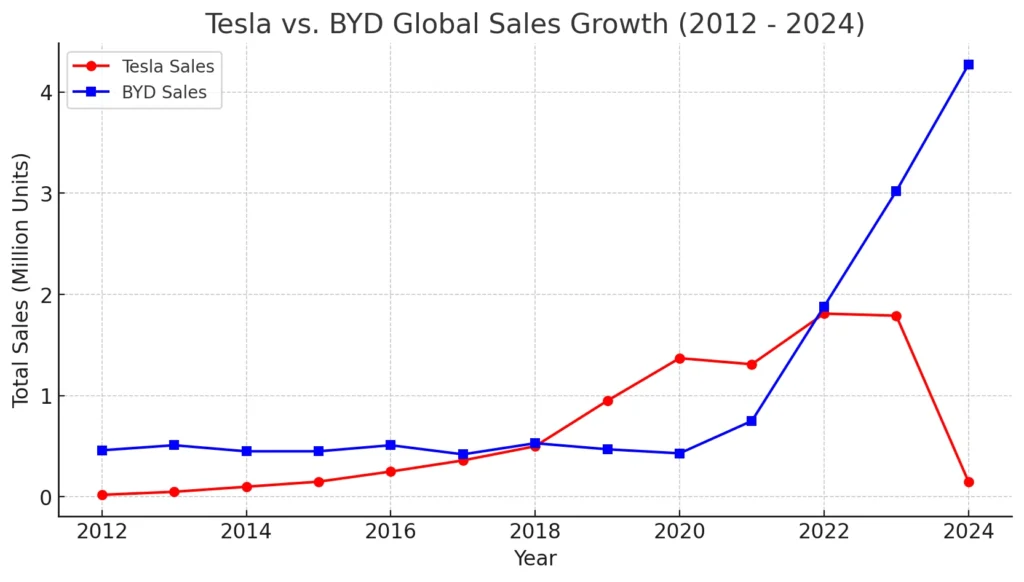For years, Tesla dominated the Chinese electric vehicle (EV) market, seen as the premium choice for those looking to transition from gas-powered cars to cutting-edge electric technology. However, the tide has turned. China’s homegrown EV manufacturers are not only catching up but are overtaking Tesla in terms of sales, innovation, and affordability.
The Rise of Chinese EV Makers
China has long been a major player in the global EV industry. With government-backed incentives, a well-developed supply chain, and aggressive competition, local car brands have evolved from underdogs into market leaders. Tesla, once the aspirational choice for Chinese consumers, is now facing serious challenges from domestic automakers like BYD, Xiaomi, and Nio, which are offering more advanced features at a fraction of Tesla's price.
BYD: The Unstoppable Force
Tesla’s biggest competitor in China is BYD (Build Your Dreams). The company, which started as a battery manufacturer, has transformed into a powerhouse in the EV industry. In the first two months of 2025 alone, BYD sold 481,318 cars, marking a 75% increase from the previous year. In contrast, Tesla’s sales dropped by 14%, with only 60,480 vehicles sold in the same period.
BYD’s lower pricing strategy and strong government support have made it a dominant force in the Chinese market. Many local governments in China encourage businesses and taxi services to adopt BYD’s models over foreign brands, further strengthening its position.

Xiaomi: From Smartphones to Smart Cars
Xiaomi, the well-known consumer electronics brand, recently entered the EV space, launching its first electric car, the Xiaomi SU7. The move has been a success, with Chinese consumers flocking to Xiaomi’s sleek, high-tech designs.
One major reason why Tesla is losing market share is perception: Tesla’s Model Y, once considered futuristic, is now viewed as ordinary. Meanwhile, Xiaomi’s vehicles, packed with AI-driven features and seamless smartphone integration, have captured the attention of younger buyers.
“Xiaomi is more fashionable,” said Liu Jie, a 32-year-old Beijing resident who opted for a Xiaomi SU7 over a Tesla. “Tesla is a little bit normal. You see Model Y everywhere.”
Why Tesla Is Losing Ground in China
1. Pricing Wars: The Cost Factor
Tesla is facing an uphill battle against Chinese competitors who are slashing prices aggressively. A new Xiaomi SU7 costs $41,305, which is on par with Tesla’s Model 3. However, other Chinese brands offer similar or better technology for as little as half the price. In a market where affordability matters, Tesla is struggling to justify its premium pricing.
Tesla has responded by introducing zero-interest financing options in China, but for many consumers, the lack of competitive pricing is a deal-breaker.
2. Advancing Technology: Falling Behind
Chinese EV makers have rapidly improved their self-driving capabilities, battery efficiency, and in-car AI. Tesla, on the other hand, has been slower to introduce its Full Self-Driving (FSD) software in China due to regulatory delays.
Tesla recently gained approval to offer a version of its Autopilot system in China, but it lags behind local alternatives. Meanwhile, BYD and Xiaomi are integrating next-generation AI features and seamless smartphone connectivity into their vehicles, making them more appealing to tech-savvy Chinese drivers.
3. Consumer Preferences Are Changing
Tesla still enjoys a strong brand presence in China, but younger consumers—particularly those born in the 1990s and 2000s—are more open to trying domestic brands.
“Tesla and BYD are still the most trusted brands in China,” said Xia Lifang, a dealership employee for Arcfox, a Chinese EV brand. “But younger buyers prefer cars that feel new and different. They want something fresh.”
This shift in consumer preference is a significant blow to Tesla, which once enjoyed cult-like popularity among Chinese tech enthusiasts.
A Shrinking Market: The Bigger Problem for Tesla
It’s not just Tesla facing trouble—the entire Chinese auto industry is struggling with declining demand.
With China’s economy slowing down, fewer consumers are rushing to buy new cars. To counteract this, the government has introduced new subsidies to encourage drivers to trade in old gas-powered vehicles for EVs. While Tesla benefits from these incentives, so do its local competitors.
A recent visit to a Tesla dealership in Beijing revealed a stark reality: sales are slowing across the board. Many Tesla showrooms have been offering discounts and trade-in deals, but foot traffic is lower than in previous years.
“It was OK two years ago, but now the market is saturated,” said Chen Jiaming, a salesperson at an FAW-Volkswagen dealership in Shanghai.
Even traditional automakers are struggling to move inventory, with some dealerships receiving months of free rent from malls just to stay afloat.
What’s Next for Tesla in China?
Tesla is at a crossroads in China. It can either adapt to the changing market conditions or risk losing its second-largest market after the U.S.
Possible Strategies for Tesla:
- Lower Prices: Tesla may need to introduce a more affordable model to compete directly with BYD’s budget-friendly offerings.
- Faster Technological Advancements: Bringing Full Self-Driving (FSD) to China sooner and integrating more AI-driven features could help Tesla regain its tech advantage.
- Deeper Localization: Tesla has been successful in manufacturing vehicles in Shanghai, but it may need to strengthen its partnerships with Chinese suppliers and technology firms to keep up with domestic brands.
Final Thoughts: Can Tesla Rebound?
While Tesla remains a respected name in China, its dominance is slipping. The company is facing strong competition from Chinese automakers who offer better technology at lower prices.
If Tesla does not innovate aggressively and rethink its pricing strategy, it risks becoming a niche player in a market it once led. With China continuing to push the boundaries of EV technology, Tesla’s future in the country depends on how quickly it can adapt to the changing landscape.
For now, Chinese consumers are sending a clear message: They want high-tech, affordable, and stylish EVs—something Tesla is struggling to deliver.
4o
O
